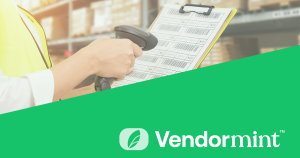Deduction Management Services & Retail Compliance
Expert Q&A on Logistics, Disputes & Recovery Optimization

Featured Experts

Angie Gautney
Senior Manager, Dispute Management at Vendormint

Jill Schilb
Account Executive at Vendormint
Date of Discussion:
October 7, 2025
Format:
Live webinar with open Q&A
Moderator:
Dallas Counts
Check out the Full Length Interview by clicking here!
Introduction
This Q&A discussion focuses on how brands can navigate deduction management, compliance alignment, and logistics document management with real-world insights from two leading experts. From warehouse to payment, Angie and Jill break down best practices in deduction recovery and dispute strategies to help brands optimize their retail supply chain workflows.
Q&A Discussion
Q: Where do brands commonly go wrong in deduction management services?
A (Angie): Many companies treat deduction recovery reactively. The key is to align your accounts receivable and logistics workflows early. Lack of documentation, like missing purchase orders or unsigned Bill of Ladings (BOLs), derails most disputes. Centralizing logistics document management is foundational.
Q: What are the most common documentation errors you see?
A (Jill): Proof-of-delivery (POD) without a clear signature or missing PRO numbers is a big issue. Some BOLs are auto-generated and missing critical metadata like PO numbers or case counts. Make sure all documents are audit-ready, especially if you’re managing high volumes.
A (Angie): I agree. Also, ensure you’re getting PODs quickly. FedEx, for example, deletes them after 90 days. Without proper archiving, you could lose thousands due to expiration.
Q: How can brands be proactive rather than reactive in managing deductions?
A (Angie): Use historical deduction data to spot trends. What’s causing your top five deduction codes? Is it pricing mismatches, shortage disputes, or invalid returns? Audit those categories monthly.
A (Jill): Review compliance scorecards from major retailers. These are part of larger supply chain optimization services. If your on-time-in-full (OTIF) score is slipping, that’s a signal upstream issues are affecting downstream disputes.
Q: What technologies or processes help centralize deduction management?
A (Jill): Deduction management software is key. It allows integration of shipping documents, payment histories, and claim codes in one dashboard. You also need EDI visibility and strong coordination between AR and logistics. Document automation tools are great for capturing PODs and BOLs at shipment time.
A (Angie): I’d add that setting up shared folders across teams is an easy win. Most breakdowns happen when Sales, Logistics, and Finance operate in silos.
Q: What is your advice for working with Walmart or other large retailers?
A (Angie): Know your retailer’s deduction portal. Walmart uses APDP and has a clear set of codes. Know them by number. Ensure your documentation supports strong supplier-retailer compliance practices. Also, learn escalation paths for when to use dispute tickets, when to escalate via partner support, and when to submit updated documentation.
A (Jill): Walmart also expects compliance with how your labels scan and how pallets are loaded. We’ve seen disputes arise just from overlapping shrink wrap. Regulatory compliance alignment solutions aren’t just policy, they’re operational.
Q: What’s your perspective on small vs. large deduction claims?
A (Angie): Don’t ignore small deductions. A large number of small, unchallenged claims or supply chain chargebacks add up quickly over time. If you ignore every $50 claim, you’re potentially losing $100K per year. Brands need a strategy, not a threshold.
A (Jill): Absolutely. Brands who only chase big dollar amounts often miss repeated deductions that indicate systemic failure.
Q: What’s the biggest misconception about deduction management?
A (Jill): That it’s purely about recovery. It’s actually about prevention. Recovery is reactive. True value comes from process fixes including EDI alignment, label compliance, and accurate item setup.
A (Angie): Brands think they can dispute everything successfully. That’s not realistic. Some deductions are valid. Knowing which battles to pick is part of smart deduction strategy.
Q: How do you recommend teams structure themselves for success?
A (Angie): Cross-functional accountability is key. Someone needs to own the dispute, but they must have access to logistics, compliance, billing, and retail accounting teams, or wholesale accounting if applicable. Shared KPIs help too, like reducing disputes per $1M in sales.
A (Jill): Don’t isolate the deduction team. Put them in touch with the warehouse team, the 3PLs, the item setup specialists, and those responsible for claims handling. Most deduction root causes don’t live in AR, they live upstream.
Q: Final advice for suppliers navigating deduction-heavy retailers?
A (Angie): Document everything. Archive all signed delivery documents to support claim validation and document retrieval workflows. Make sure you’re aligned with your carriers, and build processes around recurring deduction types.
A (Jill): Use data to your advantage. If you can’t measure it, you can’t prevent it. Supply chain optimization services should include deduction audits, compliance trend reviews, and EDI health checks.
Takeaways
- Retail deduction management is complex but solvable with the right mix of strategy, visibility, and technology to drive margin recovery and boost overall revenue recovery across your supply chain operations.
- Invest in deduction management software and logistics document management services to streamline recovery.
- Use historical deduction analytics and compliance dashboards to guide regulatory compliance alignment solutions.
- Build cross-functional teams that unify Sales, Logistics, AR, and Compliance.
- Treat deduction prevention as a key pillar of accounts receivable, chargeback prevention, and invalid deduction prevention strategy.
Stay tuned for more expert-led retail supply chain webinars hosted by Vendormint.
Interested in listening to the conversation? Check it on YouTube!
More Posts

Avoiding Costly Mistakes: A Deep Dive into Compliance & Dispute Management with Major Retailers
Expert Strategies for Retail Dispute Management, Deduction Management, Retail Compliance, and Supply Chain Optimization

Walmart Profitability and Growth: Strategies for Suppliers in Uncertain Times
In today’s retail environment, consumer packaged goods (CPG) brands face mounting pressure from tariffs, compliance fines, operational inefficiencies, and increasingly complex relationships with major retailers like Walmart.

The Walmart Supplier Quality Excellence Program (SQEP)
The Walmart Supplier Quality Excellence Program (SQEP) provides standards for a “defect-free” supply chain. Learn more about this retail supplier KPI.

Walmart On Time In Full (OTIF) Compliance
Learn about the Walmart On Time In Full (OTIF) compliance program, including KPIs, metrics, and strategies for creating a compliant retail supply chain.
When you realize
you're missing out
on all the insider info
Get in on the action and join the VendorWorld™ Newsletter—stay up-to-date with industry tips, tricks, and the latest trends.




